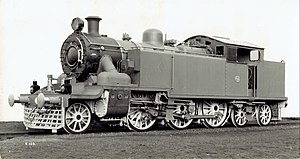Indian steam locomotive class
| Indian locomotive class PT |
|---|
 |
|
| Specifications |
|---|
Configuration:
| |
|---|
| • Whyte | 2-6-4T |
|---|
| • UIC | 1′C2′ n2t (PT class)
1′C2′ h2t (PTS/PTC class) |
|---|
| Gauge | 1,676 mm (5 ft 6 in) |
|---|
| Leading dia. | 3 ft 7 in (1,090 mm) |
|---|
| Coupled dia. | 5 ft 1+1⁄2 in (1,562 mm) |
|---|
| Trailing dia. | 3 ft 7 in (1,090 mm) |
|---|
| Wheelbase: | |
|---|
| • Engine | 34 ft 3 in (10.44 m) |
|---|
| • Coupled | 13 ft 0 in (3.96 m) |
|---|
Length:
| |
|---|
| • Over buffers | 43 ft 7+1⁄2 in (13.297 m) |
|---|
| Axle load | 15 long tons (15 t) |
|---|
| Loco weight | 76.5 t (75.3 long tons; 84.3 short tons) |
|---|
| Fuel capacity | 3 t (3.0 long tons; 3.3 short tons) of coal. |
|---|
| Water cap. | 2,000 imp gal (9,100 L; 2,400 US gal) |
|---|
| Firebox: | |
|---|
| • Type | Belpaire |
|---|
| • Grate area | 25.3 sq ft (2.35 m2) |
|---|
Boiler:
| |
|---|
| • Diameter | Standard type: 5 ft 1+1⁄4 in (1,556 mm)
SP/SG type: 4 ft 8+1⁄2 in (1,435 mm) |
|---|
| Boiler pressure | 180 psi (12.4 bar; 12.7 kgf/cm2) |
|---|
| Superheater | Schmidt (PTS/PTC class) |
|---|
| Cylinders | Two, inside (Original design)
Two, outside (SIR locomotives) |
|---|
| Cylinder size | 18.5 in × 26 in (470 mm × 660 mm) |
|---|
| Valve gear | Rotary Lentz (SIR locomotives)
Walschaerts (Other locomotives) |
|---|
|
| Career |
|---|
| Disposition | One SIR locomotive preserved, remainder scrapped. |
|---|
|
| Reference: [3][4] except where noted. |
The PT class (Passenger Tank) was a broad gauge tank locomotive designed to haul passenger trains on the railways in British India. It was one of the BESA locomotives developed by the British Engineering Standards Committee, later called the British Engineering Standards Association (BESA).
